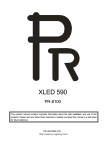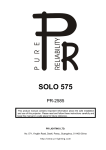Download User`s Manual - StageLightingStore.com
Transcript
PILOT 250 PR-2250 This product manual contains important information about the safe installation and use of this projector. Please read and follow these instructions carefully and keep this manual in a safe place for future reference. PEARL RIVER LIGHT & ACOUSTICS INDUSTRIAL LTD. Yingbin Road, Dashi Panyu, Guangzhou, 511430 China http://www.pr-lighting.com INDEX SECTION PAGE SAFE USAGE OF THE PROJECTOR INSTALLING THE PROJECTOR FITTING THE LAMP POWER SUPPLY – MAINS CONTROL CONNECTIONS XLR CONNECTORS 5-PIN AND 3-PIN CONVERSION DMX TERMINATOR SETUP OPTIONS – PROJECTOR CONFIGURATION SETUP OPTIONS TABLE PROJECTOR DMX START ADDRESS DMX CONTROL CHANNEL FUNCTIONS STAND-ALONE MODE CHANGING THE GOBOS MAINTENANCE LUBRICATION KEEPING THE PROJECTOR CLEAN TROUBLESHOOTING TECHNICAL DATA ELECTRICAL DIAGRAM COMPONENT ORDER CODES CHANGING OPERATING VOLTAGE AND FREQUENCY 3 4 4 5 5 5 5 6 6 7 8 8 9 10 10 10 11 11 12 13 14 15 Please note that as part of our ongoing commitment to continuous product development, specifications are subject to change without notice. Whilst every care is taken in the preparation of this manual we reserve the right to change specifications in the course of product improvement. The publishers cannot be held responsible for the accuracy of the information herein, or any consequence arising from them. Every apparatus is tested completely and packed properly by the manufacturer. Please make sure the packing and / or the apparatus is in good condition before your installation and use. Should there be any damage caused by transportation, consult your dealer and do not use the apparatus. But any damage caused by improper use will not be assumed by the manufacturer and / or dealer. ACCESSORIES THESE ITEMS ARE PACKED TOGETHER WITH THE PROJECTOR Mounting Bracket (2 PCS) M8x25 screw for mounting brackets (4 PCS) Power-cord (1 PCS), XLR plug (1 PCS), XLR socket (1 PCS), Safety cord (1 PCS) Spare gobos (4 PCS) This manual (1 PCS) INTRODUCTION Thank you for purchasing our product PILOT 250, PR-2250. This product manual contains important information about the safe installation and use of this projector. Please read and follow these instructions carefully and keep this manual in a safe place for future reference. The PILOT 250 is an innovative projector with an elegant housing, which is made from high intensity and heat–resistant complex plastic. The product complies to CE norms and standards and uses international protocol DMX 512. It can be used as a stand-alone unit or linked to a controller, so it is suitable for many different applications. The PILOT 250 features 9 colours plus white on the colour wheel, 2 gobo wheels, one with 7 indexable, interchangeable rotating gobos, one with 7 interchangeable fixed gobos. DMX controlled focus, a 3 facet rotating prism and 3 beam angles. The prism channel also has pre-programmed “macros” giving automated selection of prism and gobo combinations for easy programming and operation. The pan and tilt motor speeds are adjustable, the lamp may be switched on and off remotely and the unit may also be reset remotely. The pan and tilt have encoder wheels allowing auto position correction. A 2 blade shutter provides dimming and strobe effects. 2/16 PILOT250manualEN.doc SAFE USAGE OF THE PROJECTOR When unpacking and before disposing of the carton check there is no transportation damage before using the projector. Should there be any transportation damage keep the carton, consult your dealer and do not use the apparatus. The projector is for indoor use only, IP20. Use only in dry locations. Keep this device away from rain and moisture, excessive heat, humidity and dust. Do not allow contact with water or any other fluids, or metallic objects. The projector is not designed or intended to be mounted directly on to inflammable surfaces. The projector is only intended for installation, operation and maintenance by qualified personnel. The projector must be installed in a location with adequate ventilation, at least 50cm from adjacent surfaces. Be sure that no ventilation slots are blocked. Do not project the beam onto inflammable surfaces, minimum distance is 3m. 3m Avoid direct exposure to the light from the lamp. The light is harmful to the eye. Do not attempt to dismantle and/or modify the projector in any way. Electrical connection must only be carried out by qualified personnel. Before installation, ensure that the voltage and frequency of power supply match the power requirements of the projector. It is essential that each projector is correctly earthed and that electrical installation conforms to all relevant standards. Do not connect this device to any dimmer pack. Make sure that the power-cord is never crimped or damaged by sharp edges. Never let the powercord come into contact with other cables. Only handle the power-cord by the plug. Never pull out the plug by tugging the power-cord. Keep the lamp clean. Do not touch the lamp glass with bare hands. The projector should always be installed with a secondary safety fixing. A safety cord is supplied for this, it should be attached as shown in the “installing the projector” section. The lamp used in this projector is an MSD 250W discharge lamp. After being switched off don’t attempt to restart the projector until the lamp has cooled, this will require approx 10 to15 minutes. Switching the lamp on and off at short intervals will reduce the life of both the lamp and the projector. Never run the projector without a lamp. There are no user serviceable parts inside the projector, do not open the housing and never operate the projector with the covers removed. Always disconnect from the mains, when the device is not in use, or before cleaning it, or before attempting any maintenance work. If you have any questions, don’t hesitate to consult your dealer or manufacturer. 3/16 PILOT250manualEN.doc INSTALLING THE PROJECTOR Pass safety fixing through these holes 280mm BRACKET BRACKET BRACKET BRACKET 106mm The projector should be mounted via its bracket using 2 x M12 bolts. The brackets attach to the underside of the projector with 4 x M8x25 bolts provided. Always ensure that the projector is firmly anchored to avoid vibration and slipping whilst functioning. Always ensure that the structure to which you are attaching the projector is secure and is able to support a weight of 19Kg for each PILOT 250. For safety the projector should have a secondary fixing with a safety chain through the holes on the underside of the unit. WARNING: The projector should NEVER be lifted or carried by the yoke. FITTING THE LAMP SCREW LAMP ACCESS HATCH LOOSEN THE 2 x M4 SCREWS PULL OUT THE LAMP BRACKET TO ACCESS THE LAMP LAMP BRACKET LAMP LAMP ALIGNMENT SCREWS A,B AND C. Undo the screw on the lamp access hatch, and then remove the hatch as shown in the above figure. Undo the 2 x M4 screws (one on each side of the lamp bracket) and then pull out the lamp bracket with the old lamp. Pull out the old lamp and then plug in the new lamp. Do not touch the glass of the lamp with bare hands. Replace the lamp bracket and fasten the screws, then replace the lamp access hatch and fasten the screw. The MSD series are high pressure lamps with external igniters ( ). Care should always be taken when handling these lamps. Always read the manufacturers "Instructions for use" enclosed with the lamp. To optimize light output it will be necessary to adjust the lamp alignment to obtain an even distribution of light within the beam. The three screws (marked A, B, and C) may be gently turned to center the lamp within the reflector. The projector should be switched on with the shutter open and the beam focused to do this, it is also advisable to allow the lamp 5 minutes to come up to full brightness before starting to align it. Note: the three screws will only need a small adjustment to centre the lamp, do not try to unscrew them completely. Read the rest of this manual and then come back to this section to align the lamp. 4/16 PILOT250manualEN.doc POWER SUPPLY - MAINS L = BROWN E = GREEN/YELLOW N = BLUE FUSE HOLDER FUSE F6.3A/250V 5mm x 20mm L E N Use the plug provided to connect the mains power to the projector paying attention to the voltage and frequency marked on the panel of the projector. It is recommended that each projector is supplied separately so that they may be individually switched on and off. IMPORTANT It is essential that each projector is correctly earthed and that electrical installation conforms to all relevant standards. Power consumption of the PILOT 250 is 410W at 220V. To change the voltage and/or frequency of the Pilot 250, see the details at the back of this manual. CONTROL CONNECTIONS DMX OUT DMX IN 1 1 2 2 3 3 PIN DMX 512 FUNCTION 1 2 3 GND DATA DATA + Connection between controller and projector and between one projector and another must be made with 2 core screened cable, with each core having at least a 0.5mm diameter. Connection to and from the projector is via cannon 3 pin XLR plugs and sockets which are included with the projector. The XLR's are connected as shown in the figure above. Connect the controller’s output to the first fixture’s input, and connect the first fixture’s output to the second fixture’s input. The rest may be deduced by analogy. Eventually connect the last fixture’s output to a DMX terminator as shown in the figure below. Note, care should be taken to ensure that none of the connections touch the body of the plug or each other. The body of the plug is not connected in any way. The PILOT 250 accepts digital control signals in standard DMX512 (1990) format. No. 1 DMX OUT No. 2 DMX IN No. n DMX OUT DMX IN DMX IN FROM CONTROLLER DMX OUT TERMINATOR PILOT 250 uses 3-pin XLR plug / socket. If your controller uses 5-pin XLR plug / socket, you should convert 5-pin plug / socket into 3-pin socket / plug as shown below. 5 PIN SOCKET 3 PIN PLUG 5 PIN PLUG 3 PIN SOCKET Pin 1: GND (Screen) Pin 2: Signal (data -) Pin 3: Signal (data +) Pin 4: N/C Pin 5: N/C Pin 1: GND (Screen) Pin 2: Signal (data -) Pin 3: Signal (data +) Pin 1: GND (Screen) Pin 2: Signal (data -) Pin 3: Signal (data +) Pin 4: N/C Pin 5: N/C Pin 1: GND (Screen) Pin 2: Signal (data -) Pin 3: Signal (data +) When a DMX 512 signal is received the LED located near the digital display will illuminate green. When not receiving a DMX signal the green and red LEDs will be off, and if the green LED flashes, it means that the DMX signal is not correct. 5/16 PILOT250manualEN.doc DMX TERMINATOR In Controller mode or Master/Slave mode, the DMX output has to be connected with a DMX terminator at the last fixture in the chain. This prevents electrical noise from disturbing and corrupting the DMX control signals. The DMX terminator is simply an XLR connector with a 120Ω (ohm) resistor connected across pins 2 and 3, which is then plugged into the output socket on the last projector in the chain. The connections are illustrated below. DMX TERMINATOR CONNECTION Connect a 120Ω(OHM) resistor across pins 2 and 3 in an XLR plug and insert into the DMX OUT socket on the last unit in the chain. PIN 3 PIN 2 SETUP OPTIONS – PROJECTOR CONFIGURATION With the touch-switches and the digital display screen, the DMX start address can be easily set and the various setup options may be configured. After the projector is switched on, the projector will reset automatically and then the display will show the DMX start address (if you have already set the DMX start address and saved it, the screen will display the last setting). FUNC DOWN UP ENTER To set or browse through the various Setup Options, press the UP or DOWN button. Press the ENTER button to confirm your modification or enter a sub-option where available. Press the UP or DOWN button to modify the settings or values. Press the ENTER button to confirm your modification. For example, if you want to set the display intensity (brightness) to 100%, press the UP or DOWN buttons to select (display intensity). Press the ENTER button to enter the value setting sub-options, and press the UP or DOWN buttons to show (100%) in the display, and then press the ENTER button to save and exit. The display is now set to an intensity of 100%, maximum brightness. At any time pressing the FUNC button will return you to the previous level without saving any changes that may have been made. See the following Setup Options Table for a full listing of all available option settings. 6/16 PILOT250manualEN.doc SETUP OPTIONS TABLE RESET PAN MOVEMENT (0-255) HOT LAMP, FAIL TO START FIXED GOBO WHEEL (0-255) LAMP DAMAGED, FAIL TO START COLOUR WHEEL (0-255) ADDRESS SETTING DIMMER (0-255) CONTROLLER OPERATED SOFT RESET LAMP ON/OFF LAMP ON ON LAMP OFF OFF LAMP ON/OFF AND RESET FROM CONTROLLER RESET FAN SPEED ADJUST ON OFF HIGH SPEED LOW SPEED FIXED GOBO WHEEL LINEAR MOVEMENT ON SELF TEST OFF RUN SELF TEST DISPLAY BRIGHTNESS ADJUST COLOUR WHEEL LINEAR MOVEMENT 25% ON 50% OFF 75% UNIT OPERATING TIME 1 HOUR 100% UNIT TEMPERATURE DISPLAY LAMP OPERATING TIME 38ºC 1 HOUR MANUAL OPERATION INVERT TILT MOVEMENT STROBE (0-255) ON PAN/TILT SPEED (0-255) OFF EFFECTS WHEEL (0-255) INVERT PAN MOVEMENT PRISM (0-255) ON GOBO ROTATION (0-255) OFF GOBO WHEEL (0-255) 16 BIT RESOLUTION FOCUS (0-255) ON TILT MOVEMENT (0-255) OFF Note, to reset the Lamp Operating Time displayed, for example when you change a lamp, simply press and hold the DOWN button for more than one second while the Lamp Operating Time is being shown in the display. 7/16 PILOT250manualEN.doc PROJECTOR DMX START ADDRESS Each PILOT 250 must be given a DMX start address so that the correct projector responds to the correct control signals. This DMX start address is the DMX channel number from which the projector starts to “listen” to the digital control information being sent out from the controller. The PILOT 250 has 15 channels, so set the No. 1 projector’s address to 001, No. 2 projector’s address to 016, No. 3 projector’s address to 031, No. 4 projector’s address to 046, and so on. With the touch-switches and the digital display, the DMX start address can be easily set. Press either the UP or DOWN button to select the current DMX start address, the display may show a different number after the if a different DMX start address has already been set. Then press the ENTER button. The will start flashing, then press the UP or DOWN button to set the desired DMX start address number. Finally, press the ENTER button to save and exit. At any time pressing the FUNC button will return you to the previous level without saving any changes that may have been made. DMX CONTROL CHANNEL FUNCTIONS The PILOT 250 uses 12, 14 or 15 DMX channels depending on the setup options that have been selected. They are listed in the following table. CHANNEL 1 STROBE 2 DIMMER 3 COLOUR WHEEL 4 FIXED-GOBO WHEEL 5 PAN 6 TILT 7 FOCUS 8 ROTATING-GOBO DMX VALUES 0-9 10-249 250-255 0-255 0-9 10-19 20-29 30-39 40-49 50-59 60-69 70-79 80-89 90-99 100-109 110-119 120-129 130-139 140-149 150-159 160-169 170-179 180-189 190-199 200-225 226-229 230-255 0-24 25-49 50-74 75-99 100-124 125-149 150-174 175-199 200-255 0-255 0-255 0-255 0-31 32-63 DESCRIPTION Black Strobe from slow to fast (max. 9.3 F.P.S.) Open Linear Dimming from black to full open (0-100%) White (5-7 for 5 secs.)= Soft reset – See Note White + Colour 1 Colour 1 Colour 1 + Colour 2 Colour 2 Colour 2 + Colour 3 Colour 3 Colour 3 + Colour 4 Colour 4 Colour 4 + Colour 5 Colour 5 Colour 5 + Colour 6 Colour 6 Colour 6 + Colour 7 Colour 7 Colour 7 + Colour 8 Colour 8 Colour 8 + Colour 9 Colour 9 Colour 9 + White Forward rotation from fast to slow (rainbow effect) Stop Reverse rotation from slow to fast (rainbow effect) Open/clear GOBO 1 GOBO 2 GOBO 3 GOBO 4 GOBO 5 GOBO 6 GOBO 7 Rotate from slow to fast till scrolling effect Pan movement (0°-540°) Tilt movement (0°-265°) Focus Open/clear GOBO 1 8/16 PILOT250manualEN.doc WHEEL 9 GOBO ROTATION 10 PRISM 11 EFFECT WHEEL 12 X/Y SPEED 13 PAN 16Bit 14 TILT 16Bit 15 LAMP CONTROL AND RESET 64-95 96-127 128-159 160-191 192-223 224-255 0-149 150-153 154-201 202-207 208-255 0-7 8-15 16-106 107-110 111-199 200-204 205-209 210-214 215-219 220-224 225-229 230-234 235-239 240-244 245-249 250-255 0-50 51-101 102-152 153-203 204-255 0-255 0-255 0-255 0-109 110-119 120-159 160-179 180-219 220-239 240-255 GOBO 2 GOBO 3 GOBO 4 GOBO 5 GOBO 6 GOBO 7 Step rotation in anti-clockwise direction (0-540°) Stop (Position in 540°) Rotate from slow to fast in clockwise direction Stop Rotate from slow to fast in anti-clockwise direction No prism (white) Prism static Rotate from fast to slow in anti-clockwise direction Stop Rotate from slow to fast in clockwise direction Rotate slowly in anti-clockwise direction Macro 1 Macro 2 Macro 3 Macro 4 Macro 5 Macro 6 Macro 7 Macro 8 Macro 9 Macro 10 White Effect 1 (15.6°) Effect 2 (19.5°) Colour temperature glass 1 (3200°K) Colour temperature glass 2 (7800°K) Pan and tilt movement from slow to fast Pan 16Bit resolution Tilt 16Bit resolution Not used Lamp off Not used Lamp on (It can’t be on until after 10 minutes of lamp off) Not used Reset Not used NOTE: 1. After turning the lamp off, the “L. Hot” characters may be appeared on the display screen meaning the lamp should be cooled for 10 minutes before it can restart. If the lamp is still not lit after being switched on, the luminaire will attempt to restart the lamp automatically at intervals of 10 minutes. After 8 times of restarting, if the lamp is still off, it means the lamp is damaged and the “L. Err” appears on the display screen. 2. The speed of fans may be adjusted automatically in relation to the temperature inside the luminaire. 3. Channels 13 and 14 – high resolution Pan and Tilt, are only available if the 16 Bit Resolution option has been set to ON in the setup options of the projector. 4. Channel 15 - Lamp Control and Reset is only available if the appropriate options have been set to ON in the setup options of the projector. Soft Reset – If the option rErE is set to OFF this reset function will be available on channel 3, the colour channel. If the DMX value sent on this channel (3) stays in the range from 5 to 7 for more than 5 seconds, the projector will start a reset sequence (Remote Requested Soft Reset). The electronics are re-started and all motors moved to their home positions exactly as they do when the power is first switched on but the lamp is not switched off in this sequence, although the beam will be blacked out. STAND-ALONE MODE Press the UP or DOWN button to select (self test), and then press ENTER button to confirm it. The projector will run in stand-alone mode automatically with a programme that has been factory set. 9/16 PILOT250manualEN.doc CHANGING THE GOBOS ROTATING GOBO FIXED GOBO RETAINING SPRING SLIDE GOBO IN & OUT FROM SIDE OF WHEEL GOBO HOLDER FIXED GOBO WHEEL ROTATING GOBO WHEEL Unscrew the four (4) M4 bolts from the head cover, then carefully lift off the plastic cover Using a small screwdriver remove the rotating gobo retaining spring or push out the fixed gobo directly by hand. NOTE: the fixed gobos slide out from the edge of the wheel. Insert the new gobo (or a glass gobo) into position as shown in the figure above. For rotating gobos, remember to re-insert the retaining spring. Mount the cover again and retighten the 4 M4 screws. MAINTENANCE If the projector’s lens becomes damaged or broken it should be replaced. If the lamp becomes damaged or deformed in any way it must be replaced. If the light from the lamp appears dim this would normally indicate that it is reaching the end of its life and it should be changed at once, old lamps run to the extremity of their life can explode. If the projector does not function, check the fuses on the power socket of the projector, they should only be replaced by fuses of the same specified value 6.3A/250V (fast blow, 5mmx20mm). On the main PCB inside the projector there are also 3 fuses rated 6.3A/250V (2 PCS) and 4A/250V (1 PCS) (fast blow, 5mmx20mm). Should these be damaged call a qualified technician before replacement. The projector has a thermal protection device that will switch off the projector in case of overheating, should either of these operate, check that the fans are not blocked, and if they are dirty clean them before switching on the projector again. Check that the fans are operational, if not call a qualified technician. Any maintenance work should only be carried out by qualified technicians. LUBRICATION To ensure the continued smooth rotation of the rotating gobos and linear motion of the lens for focusing, it is recommended that the bearings for the rotating gobos and the 2 shafts for the focusing lens holder are lubricated periodically, preferably every two months. Use only high working temperature low viscosity oil. When lubricating the bearings, a syringe with a fine needle is the easiest way to introduce the oil to the bearings around each gobo. Do not over lubricate as this will cause spillage when the wheel rotates. 10/16 PILOT250manualEN.doc KEEPING THE PROJECTOR CLEAN To ensure the reliability of the projector it should be kept clean. It is recommended that the fans should be cleaned every 15 days. The lens and dichroic colour filters should also be regularly cleaned to maintain an optimum light output. Do NOT use any type of solvent on dichroic colour filters. Cleaning frequency depends on the environment in which the fixture operates: damp, smoke or particularly dirty surroundings can cause greater accumulation of dirt on the unit’s optics. A soft cloth and typical glass cleaning products should be used in cleaning. It is recommended to clean the external optics at least once every 20 days and clean the internal optics at least once every 30 / 60 days. Do not use any organic solvent, e.g. alcohol, to clean the reflector mirror, dichroic colour filters or housing of the apparatus. TROUBLESHOOTING PROBLEM The projector doesn’t switch on POSSIBLE CAUSE -The power supply is not present -The lamp is not working -Wrong DMX configuration and/or start address - Defective DMX cable -The fan has failed The lamp comes on but the projector doesn’t respond to the controller The projector only functions intermittently Defective projection -The lens is broken -Dust or grease on lenses The projected image appears to have a halo -Installation of the lamp is not correct -Dust or grease contamination on the optics. The beam appears dim -Dust or grease contamination on the optics. -The lamp is at the end of its life ACTION Check the fuse on the power socket. Replace the lamp. Make sure that the projector is correctly configured. Replace or repair the DMX cable. Make sure the fan is working and not dirty. Check the lenses are not broken. Remove dust or grease from the lenses. Make sure the lamp is installed correctly. Carefully clean the optical group lenses and the projector components. Check the optics are clean. Replace with a new lamp of the specified type and rating. LIGHT OUTPUT 19.5º LUX 1420 440 195 110 17º LUX 1750 497 221 124 15.6º LUX 2100 665 295 166 5m 4m 3m 2m 1m 15.6º 17º 19.5º 0m 2m 1m 3m 4m 5m 5 10 15 20 15.6º DISTANCE (m) DIAMETER (m) 0 Ø1.2 Ø2.5 Ø3.7 Ø4.9 17º DIAMETER (m) Ø1.4 Ø2.8 Ø4.2 Ø5.6 19.5º DIAMETER (m) Ø1.6 Ø3.2 Ø4.8 Ø6.3 11/16 PILOT250manualEN.doc TECHNICAL DATA VOLTAGES: 100/120/200/220/230/240V AC, 50Hz or 60Hz To Order. POWER CONSUMPTION: 410W @ 220V LAMP: Type : MSD 250W discharge lamp. Colour Temperature: 6700ºK Socket: GY9.5 (Single end) Manufacturers Rated Lamp Life: 2000 Hours COLOURS: 9 Dichroic colours plus white and variable speed Rainbow effect COLOUR TEMPERATURE CORRECTION: 2 Colour temperature correction filters GOBOS: Gobo Wheel 1 7 interchangeable, indexable rotating gobos plus clear Gobo Wheel 2 7 interchangeable, fixed gobos plus clear Gobo diameter: 27.8mm Gobo image diameter: 23mm SHUTTER/STROBE: 2 Blade shutter for dimmer Shutter for blackout and strobe 1 – 9.3 F.P.S. PRISMS: 1X3 Facet variable speed, bi-directionally rotating prism FOCUS: DMX controlled focus HEAD MOVEMENT: Pan 540º Tilt 265º with auto position correction (encoders) BEAM ANGLES: 15.6º, 17º, 19.5º CONTROL: DMX512: 12 Channels plus 2 for Hi Res. Pan and Tilt and 1 for DMX Lamp control MOTORS: 12 Stepper motors OTHER POINTS OF NOTE: X,Y, Motor speed adjustable Lamp On/Off control via DMX Display shows lamp and projector hours Adjustable fan speed HOUSING: Metal and composite plastic (IP20) DIMENSIONS: See drawings below. WEIGHT: 19Kg. PACKED DIMENSIONS: 450mm LONG x 450mm WIDE x 610mm HIGH PACKED WEIGHT: 21Kg. 305 480 460 530 395 515 310 370 12/16 PILOT250manualEN.doc ELECTRICAL DIAGRAM ROTATING GOBO GOBO WHEEL ROTATION COLOUR WHEEL MOTOR 8 MOTOR 9 MOTOR 10 FOCUS EFFECT WHEEL MOTOR 11 MOTOR 12 COLOUR WHEEL SENSOR GND +6V SENS D1 D2 D3 D4 ROTATING GOBO SENSOR D5 EFFECTS WHEEL SENSOR D1 - D5 = DRIVER CHIPS P/N: 170050010 DRIVER PCB 1 MICROPROCESSOR P/N: 230040124 SHUTTER 1 PRISM MOTOR 3 MOTOR 4 +30V +15V GND (UPPER POSITION) PRISM ROTATION MOTOR 5 FIXED GOBO WHEEL MOTOR 6 SHUTTER 2 MOTOR 7 GND +6V SENS D6 D7 D8 D9 FIXED GOBO WHEEL SENSOR UPPER FAN DC 12V LOWER FAN DC 12V + - + - D 10 D6 - D10 = DRIVER CHIPS P/N: 170050010 MICROPROCESSOR P/N: 230040125 DRIVER PCB 2 +30V +15V GND (LOWER POSITION) RED BLACK PAN ENCODER SENSOR LAMP SENSOR TRANSFORMER ~240V TILT ENCODER SENSOR TILT PAN MOTOR 1 MOTOR 2 BLUE ~230V BLACK ~220V BLUE ~200V BROWN ~120V BROWN ~100V FUSE T6.3A 250V (SLOW) 0V N X-C PAN TILT Y-C T-L DMX-PUT IC 1 IC 4 IC 2 + FAN ~ GND AC20Vx2 ~ ~ ~ AC12V E IC 3 IC 5 IC 6 F6.3A 250V IC 7 F6.3A 250V F4A 250V FUSES IC 8 MICROPROCESSOR P/N: 230040147 DMX IN GND +30V +15V L LAMP MAIN PCB DMX OUT BALLAST 50Hz IGNITOR THERMOSTAT 60Hz REAR SIDE 3 2 CAPACITOR 1 REAR SIDE DISPLAY PCB LAMP 50µF AC370V 13/16 PILOT250manualEN.doc COMPONENT ORDER CODES NAME PART NO. REMARK TRANSFORMER THERMOSTAT CAPACITOR BALLAST IGNITOR LOWER FAN UPPER FAN LAMP MOTOR 1 (TILT) MOTOR 2 (PAN) MOTOR 3 (SHUTTER BLADE 1) MOTOR 4 (PRISM) MOTOR 5 (PRISM ROTATION) MOTOR 6 (FIXED GOBO WHEEL) MOTOR 7 (SHUTTER BLADE 2) MOTOR 8 (COLOUR WHEEL) MOTOR 9 (ROTATING GOBO WHEEL) MOTOR 10 (GOBO ROTATION) MOTOR 11 (FOCUS) MOTOR 12 (EFFECTS WHEEL) PAN DRIVE BELT TILT DRIVE BELT IC 1 – MAIN PCB IC 2 – MAIN PCB IC 3 – MAIN PCB IC 4 – MAIN PCB IC 5 – MAIN PCB IC 6 – MAIN PCB IC 7 – MAIN PCB IC 8 – MAIN PCB D1 TO D10 ON DRIVER PCB’s 1 AND 2 MICROPROCESSOR ON DRIVER PCB1 MICROPROCESSOR ON DRIVER PCB2 MICROPROCESSOR ON MAIN PCB FOR OTHER CHIPS SEE DRAWINGS 040030037 190010054 140010045 040070053 040090016 030060001 030060008 100050018 100V/120V/230V/60Hz 95℃/10A/250V 50µF/370V 230V/50-60Hz, 250W/3.6A 230V/50-60Hz, 4-5KV 300W DC12V/2.6W 12V 0.43A MSD 250 030040052 23HS0015L 030040056 030040045 030040080 030040024 030040056 030040023 030040056 030040080 030040056 030040080 290151223 290151222 170030015 170110004 170110004 170050002 170050001 170170037 170170037 170170012 170050010 230040124 230040125 230040147 17HS0002-45L 42BYGH023A-01B(JB) 17HS0002-48L 17HS0002-03L 17HS0002-45L 23HS0002-38L 17HS0002-45L 17HS0002-48L 17HS0002-45L 17HS0002-48L HTD426-3M-8 HTD339-3M-8 LOGIC CHIP DRIVER CHIP DRIVER CHIP AMPLIFIER CHIP AMPLIFIER CHIP D/A CONVERSION CHIP D/A CONVERSION CHIP DMX CHIP DRIVER CHIPS MICROPROCESSOR MICROPROCESSOR MICROPROCESSOR CHIP ORDER CODES REAR OF DRIVER PCBs 1 AND 2 170170053 D/A CONVERSION 170170053 170170053 170170053 170170053 D/A CONVERSION D/A CONVERSION D/A CONVERSION D/A CONVERSION CHIP CHIP CHIP CHIP CHIP 170170054 DMX CHIP DISPLAY PCB (DISPLAY SIDE) DISPLAY PCB (REAR) 230040135 DISPLAY CHIP 170040036 EEPROM CHIP 170170054 DMX CHIP 14/16 170170054 DMX CHIP PILOT250manualEN.doc Changing the operating voltage and/or frequency To be carried out by qualified engineers only The power input settings of the Pilot 250 may be changed to suit the supply in the area that the unit is to be operated. The voltage and frequency is pre-set at the factory and will be marked on the exterior of the unit. Any error or mistake in setting the frequency or voltage of the projector may seriously damage the unit. Open the base of the projector by undoing the four screws on the top of the base and the 8 screws on the underside. To Change the Voltage Locate the transformer, select the appropriate voltage from 100V, 120V, 200V, 220V, 230V and 245V according to the local supply voltage. The voltages are marked on the transformer. Move only the incoming power cable that was connected to the factory set voltage as marked on the projector. Under NO circumstances should you move the cable attached to the 0V connection. It is strongly recommended that you immediately mark the new voltage on the projector so that it may not be mistaken for the factory set voltage. BLUE OUTPUT SIDE BROWN INPUT BLACK BLUE BROWN BLACK GREEN RED WHITE YELLOW BLUE 0V 100V 120V 200V 220V 230V 245V To Change the Frequency Locate the ballast in the base of the projector, and select the required frequency from 50Hz or 60Hz by moving the cable to the appropriate position. The ballast will be labeled to show the connections. Never move or disconnect the cable attached to the connector marked “Ph”. 50Hz 60Hz Ph It is strongly recommended that you immediately mark the new frequency on the projector so that it may not be mistaken for the factory set frequency. Once finished with the settings, re-assemble the base of the projector and covers. 15/16 PILOT250manualEN.doc PEARL RIVER LIGHT & ACOUSTICS INDUSTRIAL LTD. Yingbin Road, Dashi, Panyu, Guangzhou, China Post-Code: 511430 TEL: 020-8478-1888 FAX: 020-8478-6023 P/N: 321010049 Last Revision: 19:06:2003 16/16 PILOT250manualEN.doc






























